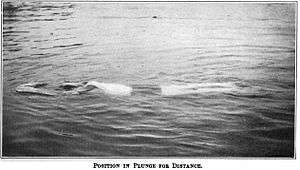Plunge for distance
|
Competitor floating after plunging (1918) | |
| First played |
1800s. English championship created in 1883. |
|---|---|
| Characteristics | |
| Type | Aquatics |
| Presence | |
| Olympic | 1904 only |
The plunge for distance is a diving event that enjoyed its greatest popularity in the 19th and early part of the 20th century, even being included as an official event in the 1904 Summer Olympics.[1] By the 1920s, it began to lose its popularity and slowly disappeared from U.S. and English swim competitions.
Description
According to the 1920 Official Swimming Guide of the American Swimming Association, the plunge for distance "is a dive from a stationary take-off which is free from spring from a height of 18 inches above the water. Upon reaching the water the plunger glides face downward for a period of 60 seconds without imparting any propulsion to the body from the arms and legs." To determine the total distance traveled, the measurement was taken from the farthest part of the body from the start, "opposite a point at right angles to the base line."[2] Generally, being heavy was an advantage in the sport.[3] The 60-second limitation appears to have been instituted at the English Plunging Championship around 1893.[4]
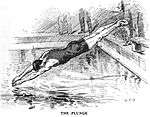
In later years, the plunge was subject to criticism as "not an athletic event at all," but instead a competition favoring "mere mountains of fat who fall in the water more or less successfully and depend upon inertia to get their points for them."[5] John Kiernan, sports writer for the New York Times, once described the event as the "slowest thing in the way of athletic competition", and that "the stylish-stout chaps who go in for this strenuous event merely throw themselves heavily into the water and float along like icebergs in the ship lanes."[6] Similarly, an 1893 English report on the sport noted that spectators were not enamored of it, as the diver "moves after thirty or forty feet at a pace somewhat akin to a snail, and to the uninitiated the contests appear absolute wastes of time."[7]
History

The exact origins of the sport are unclear, though it likely derives from the act of diving at the start of swimming races.[8][9] The 1904 book Swimming by Ralph Thomas notes English reports of plunging records dating back to at least 1865.[10] The 1877 edition to British Rural Sports by John Henry Walsh makes note of a "Mr. Young" plunging 56 feet in 1870, and also states that 25 years prior, a swimmer named Drake could cover 53 feet.[11]
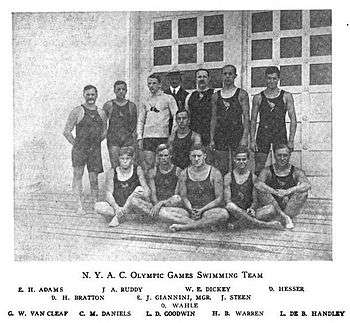
The English Amateur Swimming Association (at the time called the Swimming Association of Great Britain) first started a "plunging championship" in 1883.[7][12] By 1900 the "plunge for distance" event was being regularly mentioned in reports on U.S. swimming meets, and was mentioned in the New York Times and Brooklyn Eagle at least as far back as 1898.[13][14]
The event is best remembered today for its one-and-only Olympic appearance in 1904. William Dickey of the USA won the gold medal with a distance of 62 feet 6 inches,[15][16] which remains the Olympic record.[17] However, there were only five participants in the event, all from the United States and the New York Athletic Club.[17][18] Dickey's teammates Edgar Adams and Leo Goodwin took the silver and bronze medals, respectively.
Dickey's Olympic victory was far short of the world record at the time, which for a 60-second limit competition had been set at 79 feet 3 inches by W. Taylor of Bootle, England in September 1902.[10][19] (Without a time limit, Taylor had also traveled 82 feet in 73.6 seconds.)[10][20]
Though it never returned to the Olympics, the event remained a standard event in U.S. amateur and collegiate sporting events for some time. By 1912, S.B. Willis, a plunger at the University of Pennsylvania covered 80 feet in 60 seconds, breaking the prior U.S. record of 75 feet 11 inches held by Millard Kaiser.[21][22]
By 1917 several attempts had been made to abolish the event at college and other competitions in the United States,[23][24] and the NCAA dropped it in 1925.[25] The English A.S.A. reportedly ceased holding its official plunging championship after 1937,[12] though some sources say it ran through 1946.[26]
Female swimmers also competed in the plunge. American swimmer Charlotte Boyle (also a 1920 Olympian) set the American record a few times between 1917 and 1920, reaching 66 feet at an exhibition meet in March 1920.[27] Two Detroit Northern High School students, Helen Nolan and Dorothy McWood, set records in the early 1920s, which McWood reportedly setting a new American record of 66 feet 10 inches in April 1922.[28] Hilda Dand set a new world's record of 71 feet in 1925.[29]
On the men's side, Bootle's last record of 82 feet 7 inches set in 1906 stood for 14 years, until broken by two inches by 17-year-old Fred Schwedt of Detroit in 1920.[30] English swimmer Francis Parrington smashed that record in 1926 by traveling 85 feet 6 inches, and in 1933 he hit 86 feet 8 inches, which remains the world record.[26]
In 1941, sportswriter John Kieran referenced the sport as once "a regular event in swimming meets" but "now abandoned."[31] Since then, the sport is only mentioned occasionally in the context of "can you believe that was an Olympic event?!" news articles.[17][32]
There is some evidence that the quirky nature of the sport is occasionally gaining the attention of modern swimmers. In June 2012, Danish female swimmer Laura Funch successfully plunged the full length of a 25-meter (82 feet) pool in approximately 101 seconds.[33] Divers approached at the 2016 Summer Olympics by the press about the sport also found it fascinating.[34] Furthermore, The Michigan State University Men's and Women's swimming teams participate in this event annually at their yearly held Alumni Swimming Meet, and keep records for The Plunge event, following the same rules previously used in the early 20th Century.
Variations
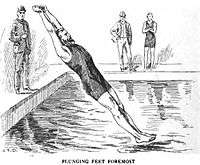
In shorter pools, a variation of the event was based on how fast the contestant traveled the length of the pool. For example, in 1927, it was reported that R.E. Howell had set a new world's record in a 60-foot tank, going "the length of the pool in 0:14 2-5."[35] Competitions were also reported at 75-foot lengths.[36]
An 1893 English book on swimming also notes the existence of a variation of plunging where participants dive feet first, which it reports to already be rarely practiced.[7]
In all plunge events, because divers could not control where they drifted after diving, typically one diver competed at a time.[7] A 1922 A.A.U. rule change planned to make plungers dive in groups, causing concern that collisions would inevitably occur among participants.[37]
Records
Compiling accurate details of record plunges presents some difficulty, as sometimes records were set in exhibition competitions, and American and English sources do not always seem to check to see whether a claimed "world record" was perhaps only a national record, but available sources do appear to confirm the following records:
Men's distance plunge world record (60 second limit)
- 86 feet 8 inches. Set on September 23, 1933 by British swimmer F.W. Parrington, the current world record[26]
- 85 feet 10 inches. 1927 by F.W. Parrington[38]
- 85 feet 6 inches. September 1926 by F.W. Parrington[39]
- 82 feet 9 inches. March 1, 1920 by American Fred Schwedt.
- 82 feet 7 inches. September 5, 1906 by W. Taylor, at Bootle, England
- 79 feet 3 inches. September 3, 1902 by W. Taylor at Bootle.[40]
- 78 feet 9 inches. September 14, 1898 by British swimmer W. Taylor
- 75 feet 7 inches. October 10, 1888 by British swimmer G.A. Blake at Lambeth Baths**
- 76 feet 3 inches. July 15, 1886 by British swimmer B. Jones (contested)[41]
- 73 feet 1 inch. March 15, 1880, by J. Strickland, in Melbourne.[8] However, dive was reportedly from 5 feet above water.[42]
- 68 feet 4 inches. July 17, 1879 by R. Green, Liverpool.[8]
- 65 feet. July 31, 1879 by T. Ingram, in London. Reported as best on record at the time by British Sporting Life.[42]
- 62 feet 8 inches. October 13, 1876 by H.J. Green, in London (though he was penalized 6 feet for unknown reasons, so accuracy may be dubious)[8][43]
- 62 feet 7 inches. October 1, 1878 by Horace Davenport.
- 56 feet 8 inches. 1870 by F. Young.[44]
- The English Plunging Championship instituted a 60-second time limit in 1893, so records prior to 1893 may be for longer times.
Men's 60 foot plunge (best time)
- 14.4 sec. (handheld) February 16, 1927 by Richard E. Howell (Chicago).[45]
- 15.4 sec. 1923 by Nathaniel T. Guernsey, Jr. of Yale University.[45] (also set records in 75 foot plunge)
- 15.6 sec. February 27, 1918 by John P. Lichter.[46]
- 16.8 sec. January 30, 1918 by Benjamin H. Princell.[47][48]
- 17.4 sec, J.P. Lichter.[47]
- 18.8 sec. February 26, 1916 by J.C.Redmond[49]
- 19 sec. February 16, 1916 by John P. Lichter.[50]
- 19.2 sec. December 8, 1915 by Craig Redmond.[51]
- 21.6 sec. February 25, 1914 by John P. Lichter.[52]
Women's distance plunge record (60 second limit)
- 71 feet. 1925 by Hilda Dand of Westminster, England[29]
- 70 feet 6 inches. 1933 by Dorothy Rennie in Vancouver, is likely the Canadian record.[53]
- 68 feet 1 inch. 1920 by Hilda Dand.[53]
- 66 feet 10 inches. Set in April 1922 by Detroit high school student Dorothy McWood. Reported as a world record in United States, though Dand may have plunged 68 feet 1 in. in 1920 (see above), in which case it would be only an American record.[28] In December 1924, however, the American men's college committee on swimming records officially stated that the American scholastic record was 62 feet 8 inches, set by McWood.[54]
- 66 feet. Late 1919 by Hilda Dand in England.[55] Charlotte Boyle matched this length in March 1920 in the United States.[56]
Women's 60 foot plunge (best time)
- 46 seconds, Alice Van Hoe, reported as United States collegiate record as of December 31, 1924.[54]
Notable plungers
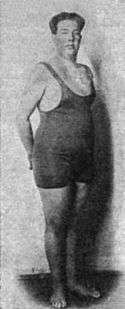
- Edgar Adams – Silver medalist at 1904 Summer Olympics, he subsequently set the U.S. plunge record a few times, last setting a record of 70 feet in December 1906.[57][58][59][60]
- G.A. Blake – English plunger who set record mark of 75 feet 7 inches on October 10, 1888.[61]
- Charlotte Boyle – set U.S. female records in the plunge, also competed as a swimmer in the 1920 Olympics.[27][28][56][62][63]
- Horace Davenport (died 1925) – English plunger who won competitions in the 1870s and 1880s, including 1884, 1885, and 1886 English Plunging Championship. Also known for plunging feet first.[64][65][66] Davenport also was known for endurance swims.[66][67]
- William Dickey – U.S. plunger from the New York Athletic Club, and winner of the 1904 Olympic gold medal
- Fred Schwedt (1902–1986) – U.S. plunger who set a reported world record at age 17 of 82 feet 9 inches on March 1, 1920, beating the 1906 mark set by W. Taylor.[30][68] Schwedt was reportedly able to coast 75 feet after 90 days of practice.[2]
- W. Taylor – Set world records in both 1-minute and untimed competitions in the late 1890s. On September 14, 1898, he floated 78 feet 9 inches in 60 seconds, setting the English A.S.A. record. In September 1902, he made it to 79 feet 3 inches.[19] On September 6, 1899 he plunged 82 feet in 73.6 seconds.[10] In 1906, he reached 82 feet 7 inches,[64] a world record which stood for many years.
- Francis Winder (F.W.) Parrington – The current world record holder for total distance, whose mark of 86 feet 8 inches was set on September 23, 1933.[26] Parrington reportedly won the English Plunging Championship 11 times between 1926 and 1939. In September 1926, Parrington broke Taylor's (and presumably Schwedt's) distance record, setting a new mark of 85 feet 6 inches.[39] A police officer, Parrington died during the Liverpool Blitz on May 8, 1941, at age 42.[69] In 1986, he was inducted into the International Swimming Hall of Fame.[26][38] Parrington's son was also a swimmer, and his grandson David Parrington (who completed for Zimbabwe at the 1980 Summer Olympics) is (as of 2011) the head diving coach at the University of Tennessee.[70]
- Charles H. Pyrah - Set the United States' plunge record of 63 feet in 1902. Finished fifth (and last) in 1904 Olympics.[32][71][72]
References
- ↑ Kehm, Greg. Olympic Swimming and Diving, p. 14 (2007)
- 1 2 Official Swimming Guide 1919-20, p. 85-86 (1920)
- ↑ Handley, Louis de B. Swimming and watermanship, p. 98 (1918)
- ↑ Spalding's official athletic almanac for 1910, p. 173
- ↑ Barnes, Gerald. Swimming and Diving, p.44-47 (1922)
- ↑ Kieran, John (16 March 1930). Sports of the Times, The New York Times
- 1 2 3 4 Henry, William and Sinclair, Archibland. Swimming, p.110-19, 411 (1893)
- 1 2 3 4 Wilson, William. The swimming instructor, p. 60-64 (1883)
- ↑ (2 August 1845). Swimming - Section III - How To Go Into The Water - Plunging, The Sportsman's magazine
- 1 2 3 4 Thomas, Ralph. Swimming, p. 149-50 (1904)
- ↑ Walsh, John Henry. British rural sports, p. 720-21 (13th ed. 1877)
- 1 2 Cox, Richard et al. Ref Encyclopedia of British sport, p. 111 (2000)
- ↑ (23 October 1898). Club Chat About Sports, The New York Times
- ↑ (16 July 1898). Knickerbocker A.C. Sports, Brooklyn Eagle
- ↑ MAtthews, George & Marshall, Sandra. St. Louis Olympics, 1904, p.85-86 (Arcadia 2003)
- ↑ (October 1904). Olympic Swimming Championships, New York Athletic Club Journal
- 1 2 3 (8 August 2008). Live pigeon shooting, anyone?, Ottawa Citizen
- ↑ Matthews, George R. America's first Olympics: the St. Louis games of 1904, p. 163 (2005)
- 1 2 Spalding's athletic almanac, p. 43 (1903)
- ↑ Corsan, George Hebden. At home in the water: swimming, diving, life saving, water sports, natatoriums, p.150 (1914)
- ↑ Colby, Frank Moore (ed.) The New international year book, p. 695 (1913)
- ↑ (10 March 1912). Willis Best Plunger, The New York Times
- ↑ (9 September 1917). FAVORS RETAINING DISTANCE PLUNGE, The New York Times
- ↑ (13 October 1913). College Swimmers Meet, The New York Times ("An attempt was also made to have the plunge for distance abandoned in favor of a fifty-yard back-stroke race, but the motion did not go through.")
- ↑ (16 April 1925). Swim Body Adopts 'Dead Start' System: National Collegiate Association Also Abolishes the Plunge for Distance, The New York Times
- 1 2 3 4 5 Bryom, Glen (15 July 2010). Zimbabwe's Frank Parrington, 85, Swimming World Magazine
- 1 2 (20 March 1920). Swimming Records Made, The New York Times (reporting that Boyle's 66 feet was both an American record and a new world's record, beating the former record of 65 feet 10 inches held by Helen Nolan of Detroit)
- 1 2 3 (26 April 1922). Sets Record, Utica Observer (reporting that Dorothy McWood of Detroit Northern High School had set new world's plunge record of 66 feet, 10 inches, breaking Helen Nolan's record by 8 inches)
- 1 2 Chambers's encyclopaedia, p. 816 (1927)
- 1 2 (2 March 1920). Plunge Record by Detroit Swimmer, The New York Times
- ↑ Keiran, John (20 January 1941). Plunging Ahead Through Hot Water, The New York Times
- 1 2 (6 July 2012). The Joy of Six: Discontinued Olympic sports, The Guardian
- ↑ (26 June 2012). Laura Funch (DEN), 25 meters in the plunge for distance, Swimmer's Daily
- ↑ Kilgore, Adam (5 August 2016). https://www.washingtonpost.com/sports/olympics/for-some-olympic-sports-the-flame-burns-out-quickly/2016/08/05/a42d694c-5b1c-11e6-9aee-8075993d73a2_story.html Plunge for distance, tug of war: The Olympics' sad history of defunct medal events], The Washington Post
- ↑ (17 February 1927). Howell of Chicago A.A. Sets New World's Mark in Plunge, The New York Times
- ↑ (17 January 1920). Yale Swimmers Defeat Columbia, The New York Times (reporting that Richard Meagher of Yale had set a new collegiate record of 47 4-5 seconds)
- ↑ (8 January 1922). Swimming Rules Arouse Criticism, The New York Times
- 1 2 FRANK PARRINGTON (GBR):1986 Honor Pioneer Diver, www.ishof.org, Retrieved July 29, 2011
- 1 2 Chambers's encyclopaedia, p. 816 (1927)
- ↑ (18 March 1905). Human Fish Club Plans for Swimming, The New York Times
- ↑ Swimming, Outing (December 1889)
- 1 2 (February 3, 1883). Amateur Swimming - Plunging, Spirit of the Times
- ↑ (19 October 1876). Swimming, The Country, p. 370, col. 3
- ↑ (16 December 1882). Notes on Sport in England, The Mercury (Hobart)
- 1 2 (17 February 1927). Howell of Chicago A.A. Sets New World's Mark In Plunge, The New York Times
- ↑ Eckersall, Walter (28 February 1918). Lichter of C.A.A. Shatters World's Record for Plunge, Chicago Tribune
- 1 2 Princell Sets New Mark in Tank, The New York Times (claimed world's record)
- ↑ Eckersall, Walter (31 January 1918). C.A.A. Natator Breaks World Plunge Record, Chicago Tribune
- ↑ Handbook for Comrades, p. 183 (1920)
- ↑ (18 February 1916). New Plunge Record, The New York Times
- ↑ (9 December 1915.) Claims New Record for 60-Foot Plunge, Bakersfield Californian
- ↑ The Chicago daily news almanac and yearbook for 1915, p. 680 (1914)
- 1 2 (23 January 1923). Lowers Record, The StarPhoenix
- 1 2 (7 January 1925). Girls' Swim Marks Receive Sanction, The New York Times
- ↑ (1 January 1920). New Plunging Record, Christian Science Monitor
- 1 2 (20 March 1920). Sets New Swim Record, Milwaukee Journal (reporting that Boyle set new record in Detroit of 66 feet on March 19, 1920)
- ↑ (2 December 1906). New Swimming Records at New York A.C. Races, The New York Times
- ↑ (24 February 1907). New Records for Swimmer Daniels, The New York Times
- ↑ Handley, Louis. Swimming: The Ideal Exercise, Outing (magazine) (September 1914)
- ↑ (12 November 1905). Adam's Record Plunge, The New York Times (reporting that Adams had set a new American record of 69 feet)
- ↑ Chambers' encyclopædia Vol. 10, p. 18 (1892)
- ↑ (10 August 1917). Miss Boyle Breaks Record, The New York Times (reporting that Boyle had set a new U.S. woman's record of 62 feet)
- ↑ Colby, Frank Moore, ed. The New International Year Book (for 1919), p. 657 (1920)(reporting that Boyle set a new American women's record of 64 feet in the plunge in 1919)
- 1 2 Sinclair, Archibald and Henry, William. Swimming, p. 405 (1916 edition)
- ↑ The Sportsman's year-book for 1880, p.104
- 1 2 Chemist & druggist, Volume 102, p. 156 ("In the 'seventies and 'eighties he held many championships, including one for a plunge of 67 ft. 4 in.")
- ↑ (23 January 1925). Veteran Swimmer Dies: Davenport, Who Swam Niagara, Succumbs In London, The New York Times
- ↑ When Life Is At Its Spring(February 1922) (includes photo of 17-year old Schwedt)
- ↑ (4 May 2011). Eighteen Merseyside police officers were killed between May 3 and 9 during 1941 Liverpool Blitz, Liverpool Echo
- ↑ Dave Parrington, UTSports.com, Retrieved July 29, 2011
- ↑ (13 February 1903). Swimmers To Compete, The New York Times (identifying Pyrah as current American record holder at 63 hold)
- ↑ The American almanac, year-book, cyclopaedia and atlas, p. 689 (1904)
